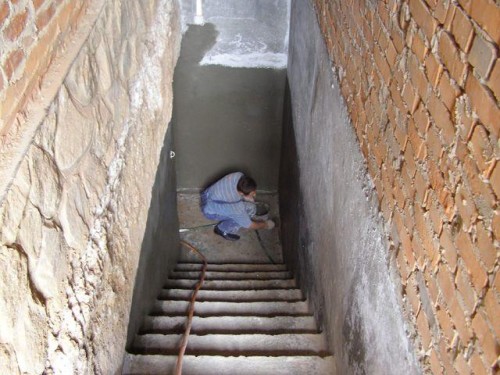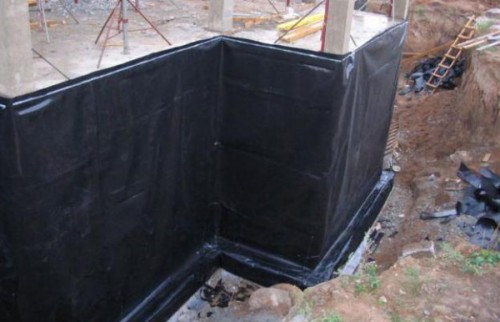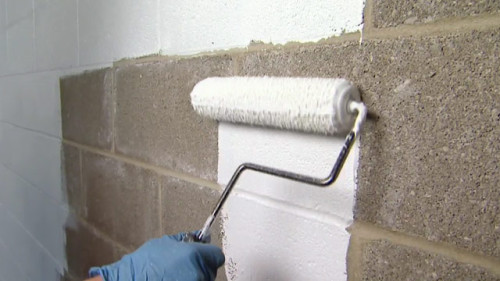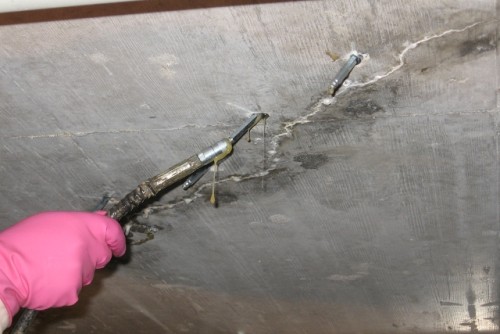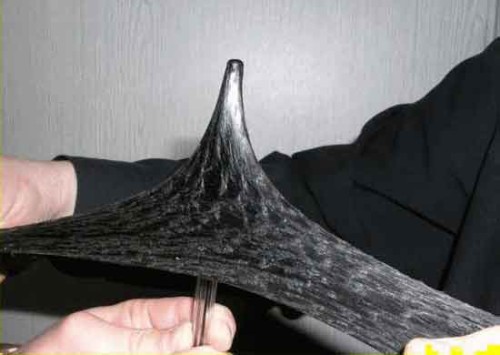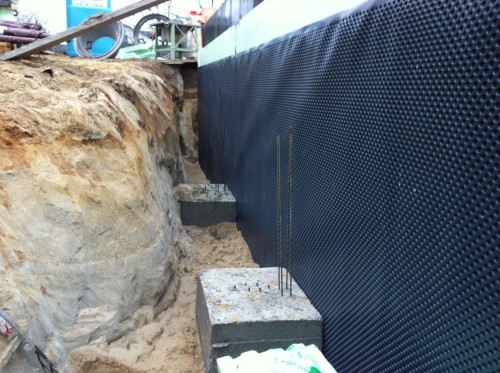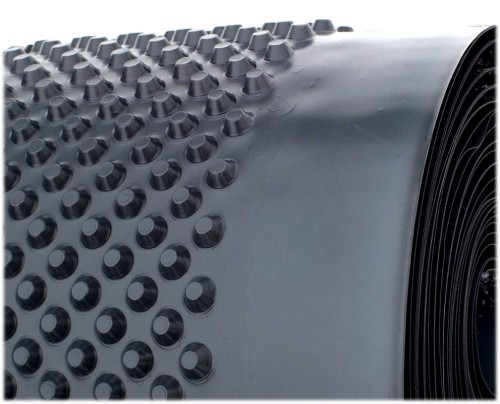
Waterproofing celled with their own hands Insulation
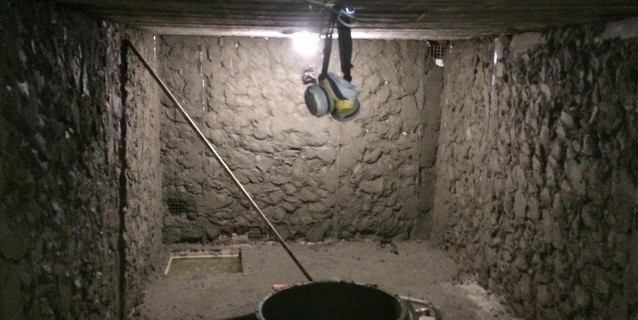
Any basement is a very specific room because it is underground. This entails a lower temperature than on the surface, the need to install a special ventilation system due to the lack of windows, as well as a constantly elevated level of humidity. Humidity in the basement is a priority problem that needs to be solved by all available ways and start work with waterproofing. How to perform waterproofing basement from water, you will learn in this article.
Content
Types of waterproofing work
Underground and sedimentary water, like any other liquids, can have a different effect on the structure, and this is affected by the mass of factors, ranging from the material from which the basement was built, ending with the characteristics of the climate and soil chemistry. Therefore, we hurry to immediately warn that the velocity protection options from moisture is invented quite a lot to satisfy all possible scenarios for the development of events. The waterproofing of the basement can be made from the inside and outside, but it is best to implement both technologies. Of course, there is often the opportunity to get to the outside of the walls of the basement room, but if the building is only at the construction stage, and the base is not covered yet, they certainly use the possibility and carry out the external waterproofing of the walls.
Given the peculiarities of the soil, the material from which the basement was built, the depth of water freezing and other factors distinguish the following types of waterproofing:
- Anticipillary - used materials act on the capillary level, penetrating the walls of the walls, gender, ceiling. Such waterproofing is called penetrating. It impresses the material on a certain thickness, after which it crystallizes, blocking microscopic pores and cracks and not allowing moisture to leak inside.
- Non-free - this species is used to protect against seasonal floods, for example, during floods or abundant rains. The main material is hot or cold mastic on a bitumen basis.
- Anti-none - applied for cases when there is no drainage, and the underground water pressure is 10 m. Creates a solid and strong water barrier using its own pressure, under the action of which the insulation strongly presses to the walls, floor or ceiling. The only condition is the anti-ph-pressure waterproofing from the outside.
By way of laying, waterproofing can be vertical and horizontal. In the first case, the material is applied to vertical surfaces. It is resorted to when the walls of the basement are at one level with underground waters, and the drainage is missing. If the vertical waterproofing of the basement walls can be performed in the construction process, and after commissioning the house, then the horizontal should be equipped at the construction stage. It is necessary when the basement is located at the level with groundwater or the house is built on clay soil, where water is forced to be for a long time and does not succeed deeper.
What you need to consider when choosing waterproofing:
- Features of the soil.
- The level of groundwater, as well as their chemical composition (the high level of salts can adversely affect some insulating materials).
- Ground freezing depth.
- Climate features in the region.
In addition to the direct waterproofing of the basement from the inside and outside the various materials use another way to reduce the impact of moisture on the underground part of the house: the improvement of drainage and the creation of a breakfast. However, the drainage system is quite difficult and not always really, in contrast to the breakfast, with the arrangement of which can cope with any hardworking owner. In the article "Skostka do it yourself" You will be able to familiarize yourself with this type of work in more detail.
Important: Even if the basement waterproofing is performed at the highest level, this is not enough to create a comfortable microclimate on the basement. In parallel with the protection and insulation of the walls, it is necessary to think about the arrangement of the ventilation system, which will derive household pairs to the outside and evaporate condensate.
Waterproofing materials
For the implementation of waterproofing measures, they are resorted to the use of various building materials. Depending on this, it is possible to distinguishrate and inlet waterproofing. When choosing one or another insulating material, it should be taken into account its adhesive abilities with respect to the surface being processed. Speaking easier, whether the isolation can be glued to the wall, the floor or the basement ceiling. Also, no need to forget about the finish finish. For internal works, many professionals are recommended to use a coating penetrating insulation, but there are also a mass of other options.
Foolish waterproofing
As you can guess from the name, all materials that can be smeared on the treated surface can be attributed to the coating isolation. Depending on the composition and nature of the impact, the paint and penetrating waterproofing of the basement is distinguished. The first remains on the surface, freezes and forms a barrier for water, the second, as you already know, seeps inside the material, freezes it and clogs all the pores.
Useful advice: To increase the protective abilities of the painting waterproofing, on top of it you can apply a layer of clay with a thickness of 4-5 cm.
One of the most popular materials of this type is the mastic technology techno. Among all its advantages can be distinguished and the fact that the "working" temperature comes to -25c, which means that they can work with mastic even in cold climatic zones. To apply compounds under the numbers 21 and 24, use an ordinary spatula or a wide brush, and №33 spare (latex-bituminous).
Among the penetrating mixtures the most popular liquid glass. It is quite easy to work with it, however, due to an increased alkaline reaction, it is necessary to use maximum personal protective equipment. Drying time of liquid glass is 5-30 minutes. For greater reliability, it is recommended to apply 2-3 layers to the surface. The advantage of any penetrating materials for waterproofing basement from the inside is also in the fact that, crystallizing inside the walls, they not only create an obstacle to water, but also strengthen the material itself, extending the use of the construction. In this case, the paropropuscability is fully preserved.
How is the waterproofing of the basement with liquid glass or other penetrating compositions:
- Clean the surface to be processed from any contaminants, degreased to open the pores. For prompt and efficient cleaning, use a water jet setting.
- To increase adhesive abilities, clean the surface with a steel bristle surface.
- Prepare the penetrating mixture according to the instructions on the package.
- Start applying waterproofing from corners and connections.
- Wait for the first layer drying, then repeat the procedure (you need to wait at least 2 hours).
- After applying the mixture, periodically spray the surface with the pulverizer with water for 3-4 days - this is necessary for the most deep penetration of the composition inside the walls and the uniform crystallization.
It is also worth mentioning the injection waterproofing, which by and large is a kind of penetrating. It is resorted to when you need to eliminate the local leakage (fracture). It is performed using a gel substance that, through special equipment, introduced in advance prepared holes. Mixtures can be acrylate, mic cement, epoxy or polyurethane based. The main advantages of injection waterproofing are low cost, the ability to perform work at any level of humidity and temperature, the absence of the need for preliminary surface preparation. In addition, the injections of gel can be done in hard-to-reach areas. However, such work is not unqualified person without equipment, so you have to hire a professional. Perforator he will try the holes, and then with the help of the injection pump, it turns the waterproofing mixture inside the crack or break in concrete.
Another popular coating material is liquid rubber. This is a generalized name of cold bitumen-polymer mastic. After applying, it freezes and forms a waterproof elastic and very durable film, stable not only to moisture, but also to serious physical exertion. Waterproofing of the basement of liquid rubber will be especially useful on highly bunched soils, where the soil movements can damage the integrity of the foundation or base. To apply the composition, use a conventional roller or brush, and even a beginner will cope with such work.
Outlet waterproofing
For inlet waterproofing, all sorts of rolled products are used, sticking them to the surface with a special mastic or removing the gas burner. Mastics are applied to a cleaned and projected surface, after which cuts of waterproofing material are pressed.
The advantages of the inlet way can be attributed to the low cost and the ability to work with their own hands without serious qualifications and the use of special equipment (with the exception of the installed isolation). However, the surface requires careful preparation, which sometimes takes more time than the waterproofing work themselves. In addition, rolled materials do not withstand a serious decrease in temperature, and when drops lose their strength.
How to work with inlet waterproofing:
- Clean the wall with a metal brush and remove dust.
- Cover the wall of the primer. You can use penetrating compound as primer and additional waterproofing.
- Wait for the full drying of the primer, then smear the bitumen mastic.
- Cut the roll on the cloth of the desired length and stick to the mastic. Place the cuts of the brass 15-20 cm, lubricating the joints of the mastic. The backstage must be made not only on neighboring cuts, but also on the walls (floor, ceiling) to ensure the insulation of the joints (the most vulnerable places).
Membrane waterproofing is a variety of rolled. Initially, the membranes were used only for external work, since they could only fulfill their purpose as an anti-pressure protection, but not so long ago, membranes for internal waterproofing appeared on the market. Therefore, if you decide to use this material, check this time from the seller. The difference between the membranes from the remaining rolled products is that there are cone-like spikes in their surfaces, designed to remove the accumulating moisture. In addition to greater efficiency, the membranes compared with the films and the rubberoid can be glued to any base, even wet. However, this does not exempt from the preparatory work - the wall must be cleared and primed. For fixing the membrane, not mastic, but dowels. Fasteners are installed only on top, after which they are equipped with horizontal insulation, which secures the free ends of the material.
Useful advice
As you can see, a variety of materials are used to waterproof the basement, but to achieve maximum results, it is necessary not only to choose the method of choose and comply with technology. We offer to familiarize yourself with a small list of professional secrets that will allow you to successfully complete the work.
Useful tips:
- If the water is "worth" the water, it is necessary to either pump it out by the pump, or to wait for it to leave herself, and only after that proceed to waterproofing work. The room before it needs to be dried.
- In order for the waterproofing material to implement all its potential, it should be applied (glued) to a well-purified surface. Neglecting this Council will not only affect the quality of work, but will also increase the consumption of materials.
- If you have to close cracks, it is pre-needed to be expanded, to dive, to be primed, and then fill in the waterproofing material.
- Never forget about the primer. It not only increases the adhesive surface abilities, contributing to a better adhesion with waterproofing material, but also significantly reduces the consumption of this material. The primer clogs microcracks and pores, in which in the case of its absence, waterproofing would be leaked, and you would have to apply it twice as much. For a better result, the primer is inflicted in 2-3 layers.
- If the house has just been built and is the probability of its shrinkage, before applying the waterproofing, attach a reinforcement fabric, hehethextile or grid to the wall. For fixing, use a wet cement solution or dowel. If the waterproofing is applied in two layers, reinforcement should also be laid between them.
- When performing horizontal insulation, always hide the walls at 20-30 cm.
- Any waterproofing materials are applied to a dry surface. The exception is only penetrating mixtures - the wet environment is necessary to leak inside the material.
- If the base of the heat is standing in the basement, do not cover its paint walls on an oil basis - it will radiate.
- The basement always leads a staircase, and it also needs high-quality waterproofing. Special attention is paid to the places of adjusting the staircase to the walls and the floor.
- Take care of the full ventilation of the basement.
Deposit all the above information video about waterproofing basement:




